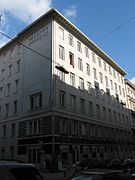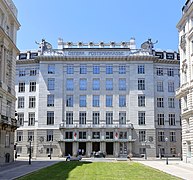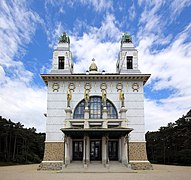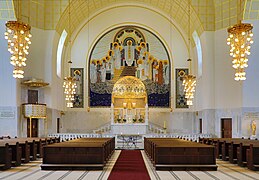Otto wagner
Otto Koloman Wagner (Penzing, July 13, 1841 – Vienna, April 11, 1918) was an Austrian architect.
Biography
Wagner was born in Penzing, a suburb of Vienna. He studied in Berlin and Vienna. In 1864, he began designing his first buildings in the historicist style. In the mid-to-late 1880s, like many of his contemporaries in Germany (such as Constantin Lipsius, Richard Streiter, and Georg Heuser), Switzerland (Hans Auer and Alfred Friedrich Bluntschli), and France (Paul Sédille), Wagner became He became an advocate of "Architectural Realism." It was a theoretical position that allowed him to mitigate his dependence on historical forms. By 1894, when he became Professor of Architecture at the Vienna Academy of Fine Arts, he had gone a long way in this direction towards a more radical opposition to the then prevailing currents of historicist architecture.
In his early days his style was characterized by robustness and classic sobriety. He later received the commission for the Vienna enlargement, of which he only carried out a part. In the mid-nineties, he had already designed several buildings in Jugendstil . Wagner was very interested in urban planning – in 1890 he designed a new city plan for Vienna, but only the urban railway network, the Wiener Stadtbahn , was built. In 1896 he published a textbook titled Modern Architecture in which he expressed his ideas about the role of the architect; It was based on the text of his inaugural speech at the Academy in 1894. His style incorporated the use of new materials and new forms to reflect the fact that society itself was changing. In his textbook, he asserted that "new human tasks and perspectives demanded a change or reconstitution of pre-existing forms." In pursuit of this ideal, he designed and built structures that reflected their intended function, such as the austere Neustiftgasse apartment block in Vienna.
He was a teacher and friend of Adolf Loos, Josef Hoffmann J. Olbrich and Jože Plečnik. He defended the young artists of the Sezession, and approached his postulates in works such as the Vienna subway stations.
In the construction of the Vienna Postal Savings Bank (1904-1906) he shows himself to be a true precursor of architectural rationalism.
In 1897, Otto Wagner, Gustav Klimt, Joseph Maria Olbrich, Josef Hoffmann, and Koloman Moser founded the artistic group called the "Vienna Secession." From the ideas of this group he developed a style that included quasi-symbolic references to the new forms of modernity.
Wagner died in Vienna in 1918.
Influence
This architect has influenced the work of other contemporary architects of his, who have inherited his avant-garde style from the end of the 19th century. Among them, and highlighting a Spanish architect, is Antonio Palacios; One of the best examples of this influence is the Day Laborers Hospital that he designed and built in Madrid.
Works
- Computers, Nußdorf, Vienna, built in 1894
- Metro Stations in Vienna (1894-1899).
- Majolikahaus (House of Mayolic), Vienna (1898-1900).
- Vienna Postal Fund (1904-1906).
- Steinhof Church, Vienna (1903-1907).
- Rumbach Synagogue, Budapest (1872).
Gallery
Contenido relacionado
Carlos Maderno
Mosque-Cathedral of Córdoba
Eero Saarinen
Antoni Gaudí
Kenzo Tange








